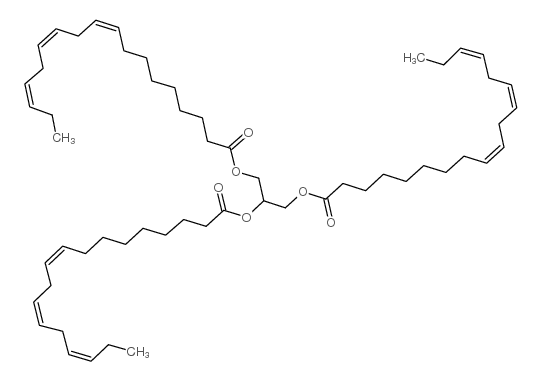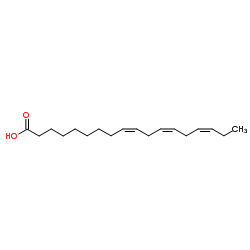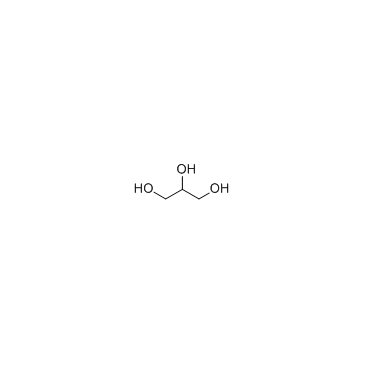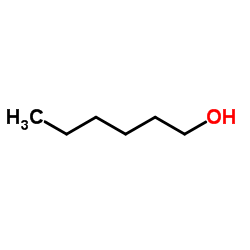Glyceryl trilinolenate

Glyceryl trilinolenate structure
|
Common Name | Glyceryl trilinolenate | ||
|---|---|---|---|---|
| CAS Number | 14465-68-0 | Molecular Weight | 873.33700 | |
| Density | 0.946g/cm3 | Boiling Point | 814.4ºC at 760mmHg | |
| Molecular Formula | C57H92O6 | Melting Point | N/A | |
| MSDS | Chinese USA | Flash Point | 303.3ºC | |
| Name | 1,2,3-trilinolenoylglycerol |
|---|---|
| Synonym | More Synonyms |
| Density | 0.946g/cm3 |
|---|---|
| Boiling Point | 814.4ºC at 760mmHg |
| Molecular Formula | C57H92O6 |
| Molecular Weight | 873.33700 |
| Flash Point | 303.3ºC |
| Exact Mass | 872.68900 |
| PSA | 78.90000 |
| LogP | 16.75310 |
| Vapour Pressure | 1.33E-26mmHg at 25°C |
| Index of Refraction | n20/D 1.489 |
| Storage condition | -20°C |
|
Section1. IDENTIFICATION OF THE SUBSTANCE/MIXTURE Product identifiers Product name: Glyceryl trilinolenate CAS-No.: 14465-68-0 Relevant identified uses of the substance or mixture and uses advised against Identified uses: Laboratory chemicals, Manufacture of substances Section2. HAZARDS IDENTIFICATION Classification of the substance or mixture Not a hazardous substance or mixture according to Regulation (EC) No 1272/2008 Not a hazardous substance or mixture according to EC-directives 67/548/EEC or 1999/45/EC. Label elements The product does not need to be labelled in accordance with EC directives or respective national laws. Other hazards - none Section3. COMPOSITION/INFORMATION ON INGREDIENTS Substances Synonyms: 1,2,3-Tri-(cis,cis,cis-9,12,15-octadecatrienoyl)glycerol 1,2,3-Trilinolenoylglycerol Glycerol trilinolenate Trilinolenin Formula: C57H92O6 C57H92O6 Molecular Weight: 873,34 g/mol Section4. FIRST AID MEASURES Description of first aid measures If inhaled If breathed in, move person into fresh air. If not breathing, give artificial respiration. In case of skin contact Wash off with soap and plenty of water. In case of eye contact Flush eyes with water as a precaution. If swallowed Never give anything by mouth to an unconscious person. Rinse mouth with water. Most important symptoms and effects, both acute and delayed Indication of any immediate medical attention and special treatment needed no data available Section5. FIREFIGHTING MEASURES Extinguishing media Suitable extinguishing media Use water spray, alcohol-resistant foam, dry chemical or carbon dioxide. Special hazards arising from the substance or mixture Carbon oxides Advice for firefighters Wear self contained breathing apparatus for fire fighting if necessary. Further information no data available Section6. ACCIDENTAL RELEASE MEASURES Personal precautions, protective equipment and emergency procedures Avoid breathing vapors, mist or gas. Environmental precautions Do not let product enter drains. Methods and materials for containment and cleaning up Keep in suitable, closed containers for disposal. Reference to other sections For disposal see section 13. Section7. HANDLING AND STORAGE Precautions for safe handling no data available Conditions for safe storage, including any incompatibilities Store in cool place. Keep container tightly closed in a dry and well-ventilated place. Containers which are opened must be carefully resealed and kept upright to prevent leakage. Recommended storage temperature: -20 °C Store under inert gas. Air sensitive. Specific end uses no data available Section8. EXPOSURE CONTROLS/PERSONAL PROTECTION Control parameters Components with workplace control parameters Exposure controls Appropriate engineering controls General industrial hygiene practice. Personal protective equipment Eye/face protection Use equipment for eye protection tested and approved under appropriate government standards such as NIOSH (US) or EN 166(EU). Skin protection Handle with gloves. Gloves must be inspected prior to use. Use proper glove removal technique (without touching glove's outer surface) to avoid skin contact with this product. Dispose of contaminated gloves after use in accordance with applicable laws and good laboratory practices. Wash and dry hands. The selected protective gloves have to satisfy the specifications of EU Directive 89/686/EEC and the standard EN 374 derived from it. Body Protection impervious clothing, The type of protective equipment must be selected according to the concentration and amount of the dangerous substance at the specific workplace. Respiratory protection Respiratory protection not required. For nuisance exposures use type OV/AG (US) or type ABEK (EU EN 14387) respirator cartridges. Use respirators and components tested and approved under appropriate government standards such as NIOSH (US) or CEN (EU). Section9. PHYSICAL AND CHEMICAL PROPERTIES Information on basic physical and chemical properties a) AppearanceForm: liquid Colour: colourless b) Odourno data available c) Odour Thresholdno data available d) pHno data available e) Melting point/freezingno data available point f) Initial boiling point and no data available boiling range g) Flash pointno data available h) Evaporation rateno data available i) Flammability (solid, gas) no data available j) Upper/lowerno data available flammability or explosive limits k) Vapour pressureno data available l) Vapour densityno data available m) Relative density0,94 g/cm3 at 20 °C n) Water solubilityno data available o) Partition coefficient: n- no data available octanol/water p) Autoignitionno data available temperature q) Decompositionno data available temperature r) Viscosityno data available s) Explosive propertiesno data available t) Oxidizing propertiesno data available Other safety information no data available Section10. STABILITY AND REACTIVITY Reactivity no data available Chemical stability no data available Possibility of hazardous reactions no data available Conditions to avoid no data available Incompatible materials Strong oxidizing agents Hazardous decomposition products Other decomposition products - no data available Section11. TOXICOLOGICAL INFORMATION Information on toxicological effects Acute toxicity no data available Skin corrosion/irritation no data available Serious eye damage/eye irritation no data available Respiratory or skin sensitization no data available Germ cell mutagenicity no data available Carcinogenicity IARC:No component of this product present at levels greater than or equal to 0.1% is identified as probable, possible or confirmed human carcinogen by IARC. Reproductive toxicity no data available Specific target organ toxicity - single exposure no data available Specific target organ toxicity - repeated exposure no data available Aspiration hazard no data available Potential health effects InhalationMay be harmful if inhaled. May cause respiratory tract irritation. IngestionMay be harmful if swallowed. SkinMay be harmful if absorbed through skin. May cause skin irritation. EyesMay cause eye irritation. Additional Information RTECS: Not available Section12. ECOLOGICAL INFORMATION Toxicity no data available Persistence and degradability no data available Bioaccumulative potential no data available Mobility in soil no data available Results of PBT and vPvB assessment no data available Other adverse effects no data available Section13. DISPOSAL CONSIDERATIONS Waste treatment methods Product Offer surplus and non-recyclable solutions to a licensed disposal company. Contaminated packaging Dispose of as unused product. Section14. TRANSPORT INFORMATION UN number ADR/RID: -IMDG: -IATA: - UN proper shipping name ADR/RID: Not dangerous goods IMDG: Not dangerous goods IATA:Not dangerous goods Transport hazard class(es) ADR/RID: -IMDG: -IATA: - Packaging group ADR/RID: -IMDG: -IATA: - Environmental hazards ADR/RID: noIMDG Marine pollutant: noIATA: no Special precautions for user no data available SECTION 15 - REGULATORY INFORMATION N/A SECTION 16 - ADDITIONAL INFORMATION N/A |
| Personal Protective Equipment | Eyeshields;Gloves |
|---|---|
| RIDADR | NONH for all modes of transport |
| WGK Germany | 3 |
|
~50% 
Glyceryl trilin... CAS#:14465-68-0 |
| Literature: Omar, Ibrahim Che; Nishio, Naomichi; Nagai, Shiro Agricultural and Biological Chemistry, 1987 , vol. 51, # 8 p. 2153 - 2160 |
|
~% 
Glyceryl trilin... CAS#:14465-68-0 |
| Literature: Journal of the American Chemical Society, , vol. 66, p. 998 |
| Precursor 3 | |
|---|---|
| DownStream 7 | |
|
Evaluation of four derivatization methods for the analysis of fatty acids from green leafy vegetables by gas chromatography.
J. Chromatogr. B. Analyt. Technol. Biomed. Life Sci. 990 , 150-7, (2015) Green leafy vegetables are valuable secondary sources of nutrients, including lipids, commonly consumed in developing countries. However, method development for the analysis of fatty acids is usually ... |
|
|
Cancer cells differentially activate and thrive on de novo lipid synthesis pathways in a low-lipid environment.
PLoS ONE 9(9) , e106913, (2014) Increased lipogenesis is a hallmark of a wide variety of cancers and is under intense investigation as potential antineoplastic target. Although brisk lipogenesis is observed in the presence of exogen... |
|
|
Accurate Mass GC/LC-Quadrupole Time of Flight Mass Spectrometry Analysis of Fatty Acids and Triacylglycerols of Spicy Fruits from the Apiaceae Family.
Molecules 20 , 21421-32, (2015) The triacylglycerol (TAG) structure and the regio-stereospecific distribution of fatty acids (FA) of seed oils from most of the Apiaceae family are not well documented. The TAG structure ultimately de... |
| 2,3-bis[[(9Z,12Z,15Z)-octadeca-9,12,15-trienoyl]oxy]propyl (9Z,12Z,15Z)-octadeca-9,12,15-trienoate |
| Glyceryl trilinolenate |



 CAS#:112-05-0
CAS#:112-05-0 CAS#:504-63-2
CAS#:504-63-2 CAS#:111-27-3
CAS#:111-27-3 CAS#:143-08-8
CAS#:143-08-8 CAS#:88275-23-4
CAS#:88275-23-4 CAS#:2190-25-2
CAS#:2190-25-2 CAS#:1867-91-0
CAS#:1867-91-0